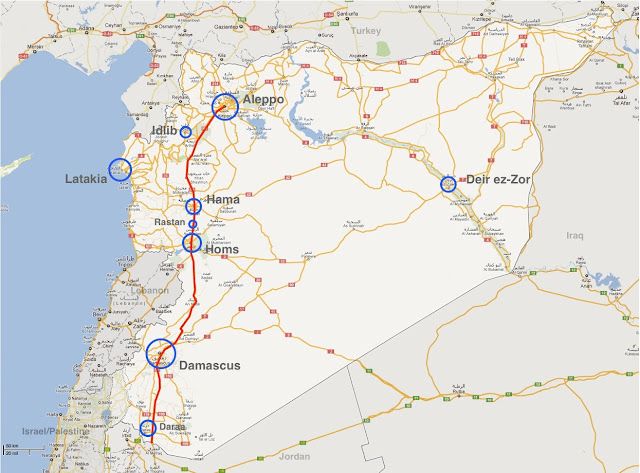Please notice: this is a layman's post. If you read it please don't skip the notes at the bottom. Also before you decide what to think of my writings: please read through my latest post (plead added 03/06/2014).
Damascus - Aleppo
In the map below I want to point to a special geographical aspect of the present conflict in Syria. As can be seen on the map the two largest cities - Damascus and Aleppo - are placed relatively fare apart; keeping those two cities connected is a central part of maintaining control of the country, and scenario where Aleppo is cut off from Damascus would significantly increase the chance/risk of the regime loosing control of the city, which - I believe - would seal their fate.
 |
| Screen shot from Google Maps with markings by me. Red line is the M5 highway linking Damascus to Aleppo. - I apologize for leaving out a lot of important places. |
The M5 highway/motorway (red line on the map above) is quite illustrative of this specific phenomenon, and the importance of controlling this route is easily understood.
What also becomes clear from studying the map is that the cities Hama, Homs and Rastan are placed in key positions. Loosing control of those cities will to a large degree isolate Damascus from Aleppo, which must be considered extra critical to the regime.
From the data listed below it shows that Aleppo is equal to Damascus in size.
Also, if the metropolitan areas of Homs and Hama are combined with the city of Rastan (61,000) the population reaches about 1.28 million. Given the strength of opposition in these cities it's a quite considerable number to have placed in this strategic area.
Also, if the metropolitan areas of Homs and Hama are combined with the city of Rastan (61,000) the population reaches about 1.28 million. Given the strength of opposition in these cities it's a quite considerable number to have placed in this strategic area.
- urban population: 1.7 million
- with surrounding governorate of Rif Dimashq: 4.45 million
- urban population: 2.1 million
- governorate: 4.75 million
- urban population: 650,000 (metropolitan area: 750,000)
- governorate: 1.75 million
- urban population: 312,000 (metropolitan area: 465,000)
- governorate: 1.6 million
- urban population: 98,000 (metropolitan area: 126,000)
- governorate: 1.45 million
..
The distances:
Damascus - Aleppo: 340 km
Damascus - Homs: 150 km
Homs - Hama: 45 km
Hama - Aleppo: 145 km
Damascus - Daraa in the south: 105 km
The distances:
Damascus - Aleppo: 340 km
Damascus - Homs: 150 km
Homs - Hama: 45 km
Hama - Aleppo: 145 km
Damascus - Daraa in the south: 105 km
| Photo from bramvangelder's Panoramio account with view of the M5 approaching Rastan from the North. |
* note: all population figures are based on estimates given in Wikipedia, and all distances between cities measured on Google Map following the M5.
.. 






